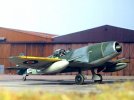OK, this is a little out there, and likely has already been thought of before, but I was considering rocket and jet development during and after WWII and wondered what could have been done that was 'simpler' than a traditional jet engine. Of course the obvious thing is a ramjet (for varying degrees of 'simpler'), using a rocket to push it up to speed before starting the ramjet. It was already known of in principal at the time and could have been done, but getting a craft close to or beyond the speed of sound in the 30s or early 40s is a not really likely.
Then I had a thought.
What if the rocket was inside the ramjet? ie, the cone on the intake had, at it's rear, a small rocket creating a supersonic flow inside the engine, and at the same time sucking air from the front via Bernoulli flow, then adding more fuel and igniting like a traditional ramjet. No turbines, no moving parts other than the rocket engine itself and the ramjet fuel injectors. Wouldn't be as efficient as a jet engine as the rocket would need oxidizer, even if most of the ramjet dominated the thrust, though once you pushed it close to the speed of sound you could shut off the rocket.
I know, Ramjets were always hard to do in of themselves so it may be more complicated than a turbojet engine anyway, but I just wondered if a) that was at all possible, and b) if it was possible earlier than turbojets, and c) if someone has had the idea before anyway. I'm assuming so as there has been an awful lot of work on ramjets done over the decades, a ton in the 50s and 60s alone.
Then I had a thought.
What if the rocket was inside the ramjet? ie, the cone on the intake had, at it's rear, a small rocket creating a supersonic flow inside the engine, and at the same time sucking air from the front via Bernoulli flow, then adding more fuel and igniting like a traditional ramjet. No turbines, no moving parts other than the rocket engine itself and the ramjet fuel injectors. Wouldn't be as efficient as a jet engine as the rocket would need oxidizer, even if most of the ramjet dominated the thrust, though once you pushed it close to the speed of sound you could shut off the rocket.
I know, Ramjets were always hard to do in of themselves so it may be more complicated than a turbojet engine anyway, but I just wondered if a) that was at all possible, and b) if it was possible earlier than turbojets, and c) if someone has had the idea before anyway. I'm assuming so as there has been an awful lot of work on ramjets done over the decades, a ton in the 50s and 60s alone.

